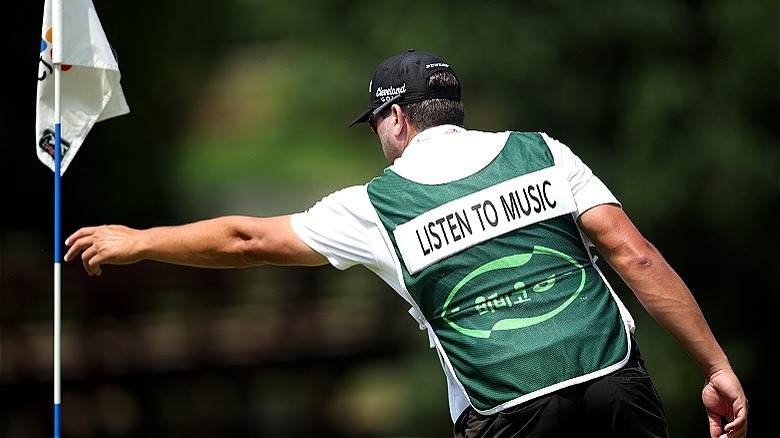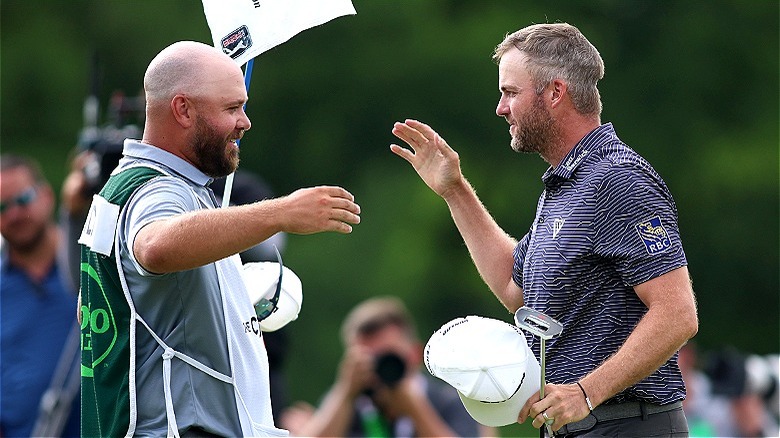This Is How Much Money PGA Tour Caddies Really Make
The PGA Tour is in full swing now — no pun intended — and the field is making its way around the circuit with the usual fanfare. Scottie Scheffler is once again the Masters champion in 2024, taking home $3.6 million for his efforts over the Masters weekend in April. Earnings can vary dramatically among tour pros, but newcomers are guaranteed a base pay of $500,000 nowadays. But what about their trusted partners? Each player traverses the gauntlet of 72 holes over four rounds (one per day from Thursday to Sunday) on their journey from tee off to the final sprint; they do this with the help of a caddie who not only carries their clubs, but acts as an equal partner in the success or heartbreak of the voyage.
Before the first tee on a Thursday, professional golfer caddies have meticulously walked the course and noted key distances, crucial slopes, and trap locations, and developed a comprehensive strategy built to maximize their golfer's swing path and game. Caddies know their golfer's distances by heart and are integral partners in club selection, shot-shaping decisions, and green reading. A successful golfer simply cannot hope to be crowned champion on any given weekend without the input of their most trusted confidant. So, with that said, how much do these white jumpsuit-cladded heroes in the background make for their efforts?
Base pay for caddies is standard
In the PGA's recent past, tour players who didn't make the cut went home empty-handed — or with very small earnings. This isn't the case any longer with a bevy of sponsorship deals in place and the base-pay resolution making its way into effect for Korn Ferry qualifiers and new participants. These are the golfers most in jeopardy of missing out on earnings, since they are often new to the highest level of competition and generally most at risk of losing their tour card.
Caddies face the same financial security concerns as the modern player. Caddies report they earn roughly $2,000 per week, as a sort of initial measuring stick. However, it's worth remembering that this figure is per week of work. There are 36 official PGA Tour events in the 2024 season, meaning 36 weeks of golfing work to tackle for a caddie-and-golfer duo. And, tour pros commit to playing at least 20 events on the schedule, skipping some for rest or added personal practice time ahead of larger competitions.
As a result, the average caddie might earn $40,000 then as their base salary if they work with a player across 20 PGA Tour events, before paying for their own travel expenses and other incidentals. Caddies also note players may drop out for an extended period when dealing with injuries, leaving their caddies idle and looking for other players to work with temporarily. This can give a caddie weeks without pay, or the potential to pick up additional gig work.
Bonuses and a cut of the winnings are typical, too
On top of their salaries, PGA Tour caddies earn a cut of the winnings from each tournament. The specifics will vary by partnership, but the average caddie will take home around 7% of the prize money that their golfer bags at the end of a tournament weekend, with some caddies taking home 5% when their player doesn't crack the top 10. This figure rises to 10% when a player wins an event, though. Therefore, Scottie Scheffler's caddie, Ted Scott, would have earned a cool $360,000 for his contribution to his golfer's capture of another green jacket (and Scheffler's second major overall).
In 2021, the average PGA Tour professional won $1,485,055. At a 7% payout rate (assuming zero outright wins to eliminate this variable) the typical caddie would have netted around $103,594 in shared winnings (plus the bump for victories) on top of their base pay. Note that caddies are often paid bonuses at the end of the year, too. These will all be personalized thank-you's from their tour pro partner, so it can be difficult to find transparency or rough averages here.
There are other incentives to consider as well. The Valspar Hat Program is an independent bonus opportunity caddies can utilize. Wearing a Valspar hat (with some interesting point addition rules) while on the course gives caddies an average financial incentive between $5,000 and $8,000.


